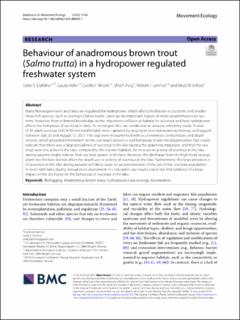| dc.contributor.author | Dahlmo, Lotte Svengård | |
| dc.contributor.author | Velle, Gaute | |
| dc.contributor.author | Nilsen, Cecilie Iden | |
| dc.contributor.author | Pulg, Ulrich | |
| dc.contributor.author | Lennox, Robert | |
| dc.contributor.author | Vollset, Knut | |
| dc.coverage.spatial | Norway, Aurlandselva, Vassbygdevatnet | en_US |
| dc.date.accessioned | 2024-02-09T09:46:00Z | |
| dc.date.available | 2024-02-09T09:46:00Z | |
| dc.date.created | 2023-11-01T10:19:52Z | |
| dc.date.issued | 2023 | |
| dc.identifier.citation | Movement Ecology. 2023, 11 (1), . | en_US |
| dc.identifier.issn | 2051-3933 | |
| dc.identifier.uri | https://hdl.handle.net/11250/3116555 | |
| dc.description.abstract | Many Norwegian rivers and lakes are regulated for hydropower, which afects freshwater ecosystems and anadromous fish species, such as sea trout (Salmo trutta). Lakes are an important feature of many anadromous river systems. However, there is limited knowledge on the importance of lakes as habitat for sea trout and how hydropower afects the behaviour of sea trout in lakes. To investigate this, we conducted an acoustic telemetry study. A total of 31 adult sea trout (532±93 mm total length) were captured by angling in river Aurlandselva, Norway, and tagged between July 20 and August 12, 2021. The tags were instrumented with accelerometer, temperature, and depth sensors, which provided information on the sea trout’s presence and behaviour in lake Vassbygdevatnet. Our results indicate that there was a large prevalence of sea trout in the lake during the spawning migration, and that the sea trout were less active in the lake compared to the riverine habitats. An increase in activity of sea trout in the lake during autumn might indicate that sea trout spawn in the lake. However, the discharge from the high-head storage plant into the lake did not afect the depth use or activity of sea trout in the lake. Furthermore, the large prevalence of spawners in the lake during autumn will likely cause an underestimation of the size of the sea trout population in rivers with lakes during annual stock assessment. In conclusion, our results could not fnd evidence of a large impact of the discharge on the behaviour of sea trout in the lake. Biologging, Anadromous brown trout, Hydropower, Lake ecology, Acceleration | en_US |
| dc.language.iso | eng | en_US |
| dc.rights | Navngivelse 4.0 Internasjonal | * |
| dc.rights.uri | http://creativecommons.org/licenses/by/4.0/deed.no | * |
| dc.subject | Biologging | en_US |
| dc.subject | Anadromous brown trout | en_US |
| dc.subject | Hydropower | en_US |
| dc.subject | Lake ecology | en_US |
| dc.subject | Acceleration | en_US |
| dc.title | Behaviour of anadromous brown trout (Salmo trutta) in a hydropower regulated freshwater system | en_US |
| dc.title.alternative | Behaviour of anadromous brown trout (Salmo trutta) in a hydropower regulated freshwater system | en_US |
| dc.type | Peer reviewed | en_US |
| dc.type | Journal article | en_US |
| dc.description.version | publishedVersion | en_US |
| dc.rights.holder | © 2023 The Authors | en_US |
| dc.subject.nsi | VDP::Zoologiske og botaniske fag: 480 | en_US |
| dc.subject.nsi | VDP::Zoology and botany: 480 | en_US |
| dc.source.pagenumber | 0 | en_US |
| dc.source.volume | 11 | en_US |
| dc.source.journal | Movement Ecology | en_US |
| dc.source.issue | 1 | en_US |
| dc.identifier.doi | 10.1186/s40462-023-00429-7 | |
| dc.identifier.cristin | 2190907 | |
| dc.relation.project | Norges forskningsråd: 320726 | en_US |
| dc.source.articlenumber | 63 | en_US |
| cristin.ispublished | true | |
| cristin.fulltext | original | |
| cristin.qualitycode | 1 | |

